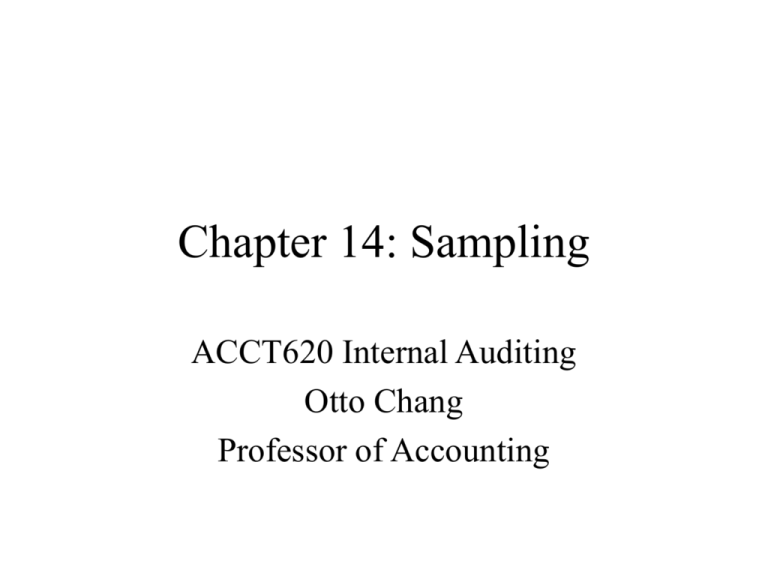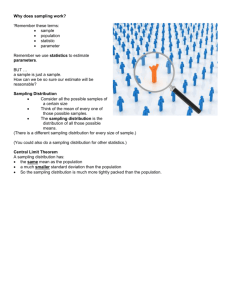A620ch14
advertisement

Chapter 14: Sampling ACCT620 Internal Auditing Otto Chang Professor of Accounting Advantage of Statistical Sampling • It quantifies sampling risk, both the risk of false alarm and the risk of non-detection • It assist auditors in designing an efficient sample • It is an objective, verifiable technique for gathering audit evidence • Many soft wares are developed to make it easy to do. The Influence of Audit Objectives on Sampling Method • Attribute sampling: focus on the the existence of some attribute, suited for testing internal control • Discovery sampling: used when little to no noncompliance is expected. A subset of attribute sampling in which the discovery of one error means noncompliance rate was too high • Sequential (stop-or-go) sampling: used when low population error rate is expected to minimize sample size. • Variable sampling: used to asses a monetary or any measure of quantity, i.e, testing A/R, inventory, fixed assets • Dollar Unit Sampling or Sampling with Probability proportional to size (PPS): each dollar is viewed as a sampling item and is either correct or incorrect. It is an attribute sampling with conclusion expressed as a dollar amount rather than an error rate. Used mostly to test overstatement. • Multi-stage or layered sampling: non-random method that tests only certain aspects of differentially defined population, i.e., select certain procedures on certain days in certain stores located in certain regions • Cluster sampling: non-random method that selects a group (cluster) of items rather than individual items, i.e., a barrel of tires, or a filing cabinet drawer of documents Sampling Terminology • Population: the audit universe, the totality of something auditors want to reach a conclusion • Sample: a subset of the population, generally randomly drawn • Representativeness: similarity between the sample and the population • Sampling unit: the item included in the sample • Sampling size: The number of items in the sample Sampling Concepts • Random samples: a sample selected by the use of – a random number table, if population is pre-numbered – systematic selection (interval sampling) with multiple random starts if not pre-numbered • Stratified sampling: a population is broken into sub-population to minimize variability within a particular stratum. It is more efficient than random sample. Sample size • Required sample size increase as population size increases but at negligible rate • Required sample size increase dramatically (by the square of the relative change) as standard deviation (sample variability) increases. To reduce sample variability, use difference or ratio approach rather than mean-per-unit estimation. • Required sample size increases as required precision of estimates narrows Sampling Concepts • Expected error rates: the error rate expected to be found in population. A high rate increases required sample size in attributes sampling • Precision: desired allowance for sampling risk, tied into auditor’s evaluation of materiality, usually indicated as an interval around sample estimates • Tolerable rate: maximum rate of error auditors would accept and still assess controls to be effective Sampling Concepts • Sampling risks: – Type I error (Alpha risk): incorrect rejection while population is reasonably stated. – Type II error (Beta risk): incorrect acceptance while population is not reasonably stated. Related to audit effectiveness, more critical to auditors. • Confidence Interval or reliability:is the complement of risk. Example of Discovery Sampling • Objective: to determine if fictitious employee have been added to the payroll • Sampling Plan: – – – – – – – Population: all employees on the payroll last year (9,500) Sampling unit: each employee Nature of errors: entering of fictitious employee Sampling risk: 5%, 95% confidence interval Sample size: 300 (tolerable error rate at 1%) Evaluation phase: no fictitious employee were found Interpretation: fraud is not present (95% of confident) Attribute Sampling • Objective: to determine if credit is checked for sales > $1,000 • Sampling plan: – – – – – Population: all A/R >$1,000 over last year (30,000) Sampling unit: customer with A/R > $1,000 Nature of errors: credit check was not performed Sampling risk: 5% or 95% confidence level Sample size: 300 (expected error rate=2% and tolerable error rate=4%, precision=2% ) – Evaluation phase: 5 (1.7%) deviations were identified – Interpretation: true error rate is < 3.9% (95% confidence level) Variable Sampling • Objective: to assess the reasonableness of recorded CIP at $2,400,000 • Sampling Plan: – – – – – Population; 1,000 homes in CIP Sampling unit: each home Nature of error: misstatement of CIP Sampling risk: 10%, 90% confidence level Sample size: 286 (standard deviation from pilot sample of 40 homes = $3,000, desired precision= $247,500, after a finite correction factor – Evaluation: $22,000,000 + $244,588 – Interpretation: CIP overstated Dollar Unit Sampling • Objective: to assess if A/R are overstated • Sample plan: – – – – – – Population: all (20,000) A/R recorded at $5,600,000 Sampling unit: each dollar in recorded A/R Nature of error: misstatement of A/R Method of selection: systematic Sampling risk: 5% Sample size: 112 (upper precision limit=$150,000 and expected errors=3 and percentage of error size=100%) – Evaluation: $352,800 (population value $5,600,000 x reliability factor 0.063 from Ex. 14-J) – Interpretation: A/R is overstated









